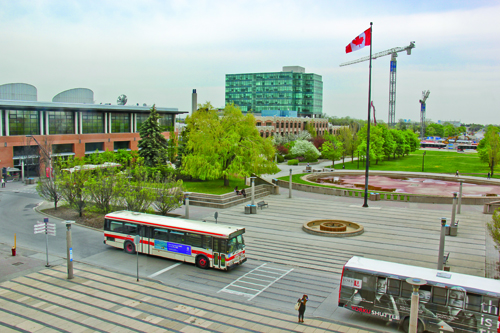When the York subway extension is complete, all bus services currently on campus will be rerouted.
According to Robert Castle, senior executive officer, vice-president finance and administration, GO, Toronto Transit Commission, VIVA/York Region Transit, and ZUM buses will no longer serve the Keele campus.
The TTC currently has a set completion date for the subway in late 2016.
Castle says York has expressed a desire to remove over 1,800 busses from the Harry W. Arthurs Common when the subway arrives on campus. [su_quote] “With the removal of the buses, the Common could revert to a pedestrian focus, which was the original intent of the Common,” says Castle. [/su_quote]
He explains that GO buses will use the Highway 407 subway station, VIVA/YRT will terminate on the north side of Steeles at the Pioneer Village Station, TTC will use the terminal on YU lands at Pioneer Village Station, and ZUM will either terminate at the 407 station or at Vaughan Metropolitan Station.
Castle says the arrival of the subway will transform the commuter experience at York.
Go Transit, however, says details on service changes will be provided closer to the completion date.
Adrian Kawun, manager of service planning for YRT/VIVA, says YRT and York are currently looking at ways that transit can still enter the York campus, as according to Kawun, customers have a expressed concerns about the walking distance from the subway station north of York University’s station.
Kawun adds that YRT is not entirely concerned with students commuting using north and south routes, but for students travelling east and west.
Christina Joseph, construction liaison officer of TTC, says some TTC bus services will continue to operate on Ian Macdonald Boulevard and The Pond Road.
Joseph says all TTC buses currently serving the campus will be affected in some way, and that the 196 Rocket will be eliminated.
Doug Rieger, manager and service development of Brampton Transit says Brampton Transit is currently seeking options to serve the campus.
“We want to be able to best meet the needs of our customers and we are currently assessing those needs in order to come up with an appropriate service design,” says Rieger.
He notes some commuters will have reduced travel times while others may experience longer ones to transfer between transit providers.
“Once open, it is anticipated that the York U station will be one of the busiest in the TTC system,” Castle adds.
As for potential concerns with increased travel costs, that has yet to be discussed.
Both Castle and Joseph note, however, that fare integration systems are being studied and developed by Metrolinx for multiple transit systems.
Ashley Glovasky
News Editor
Image source: Kinga Szymczyk
Surface transit to vacate York Commons after subway opens


